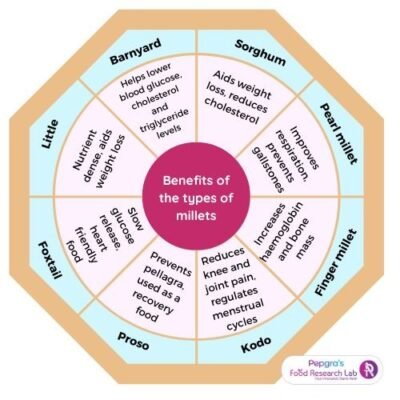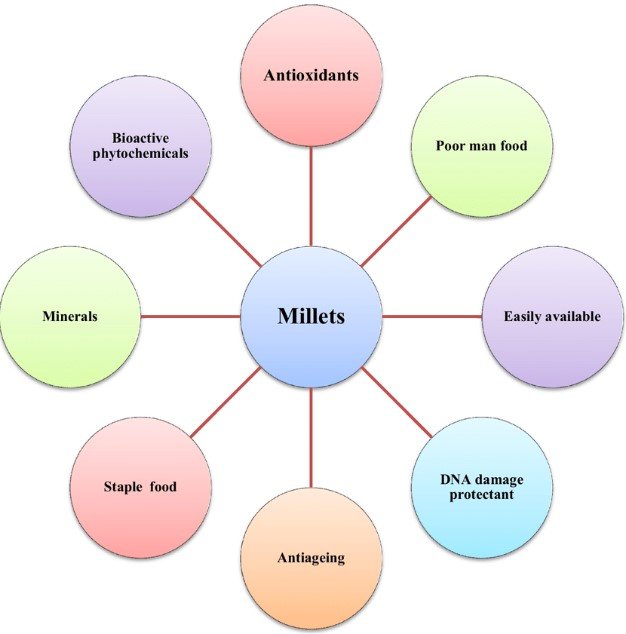Millets play a vital role in ensuring health and nutritional security in India due to their high nutritional value, climate resilience, and adaptability to different agro-climatic regions. As traditional staple foods in India, millets are gaining renewed attention in combating malnutrition, improving public health, and supporting sustainable agriculture. Here’s how they contribute to health and nutritional security:

1. Nutritional Value
Millets are nutrient-dense grains, rich in essential nutrients like proteins, vitamins, minerals, and dietary fiber. Their high nutritional content makes them ideal for addressing malnutrition, especially in rural areas where access to diverse diets may be limited.
- High Protein Content: Millets such as pearl millet and finger millet are rich in protein, which is crucial for muscle development and tissue repair.
- Rich in Micronutrients: Millets are excellent sources of iron, calcium, magnesium, and phosphorus. For instance, finger millet (ragi) contains higher levels of calcium compared to other cereals, helping to combat calcium deficiency and promoting bone health.
- Vitamins: Millets contain B vitamins like niacin, B6, and folic acid, which are essential for metabolism, energy production, and reducing the risk of birth defects.
2. Health Benefits
Millets are gluten-free and have a low glycemic index, making them suitable for individuals with dietary restrictions or chronic diseases.
- Diabetes Management: Millets have a low glycemic index, meaning they release glucose into the blood slowly, helping in the management of diabetes by maintaining stable blood sugar levels.
- Heart Health: The high fiber content in millets helps reduce cholesterol levels, promoting cardiovascular health and lowering the risk of heart disease.
- Digestive Health: Millets are rich in dietary fiber, which aids digestion, prevents constipation, and supports overall gut health.
- Obesity Control: Millets are low in fat and high in fiber, making them a good choice for weight management and reducing obesity-related health risks.
3. Climate Resilience and Food Security
Millets are known for their resilience to harsh environmental conditions, including drought, poor soil quality, and high temperatures. This makes them particularly important for food security in regions prone to climate variability.
- Drought Tolerance: Millets like sorghum and pearl millet can grow in arid and semi-arid regions with minimal water requirements, ensuring a reliable food source even during drought conditions.
- Short Growing Season: Millets have a short growing cycle, which allows them to be harvested multiple times a year, contributing to consistent food availability.
- Sustainable Agriculture: Millets require fewer inputs such as water, fertilizers, and pesticides compared to other cereals like rice and wheat. This makes millet cultivation more sustainable and environmentally friendly.
4. Economic Security for Farmers
Promoting millet cultivation can provide economic benefits to small and marginal farmers who grow them in rain-fed regions. The revival of millet production has the potential to boost rural livelihoods, especially in dryland areas.
- Low Input Costs: Millets grow well in poor soils without the need for excessive fertilizers or water, reducing the financial burden on farmers.
- Market Potential: With increasing awareness about the health benefits of millets, there is growing demand in both domestic and international markets. This opens up new income opportunities for farmers.
5. Government Initiatives for Millet Promotion
The Indian government has recognized the importance of millets for food and nutritional security and has implemented several policies and programs to promote their cultivation and consumption.
- The National Year of Millets (2018): This initiative aimed to increase awareness about the health benefits of millets and promote their use as a staple food.
- International Year of Millets (2023): India, as a key advocate, played a significant role in the UN declaration of 2023 as the International Year of Millets, further pushing global and national efforts to promote millet consumption.
- Inclusion in Public Distribution System (PDS): The government has included millets in the PDS to ensure their availability to low-income households, thus improving nutritional outcomes in vulnerable populations.
- Promotion in Mid-Day Meal Schemes: Several states have started incorporating millets in school meal programs to enhance the nutritional intake of children, addressing childhood malnutrition.
6. Contribution to Addressing Malnutrition
Millets can play a key role in addressing malnutrition, especially in rural and tribal areas where access to diverse and nutrient-rich foods is limited.
- Combating Anemia: With high levels of iron and folic acid, millets help combat anemia, especially in women and children.
- Supporting Maternal and Child Health: The high nutrient density of millets supports the health of pregnant women and children, reducing the risk of undernutrition.
Conclusion
Millets are crucial for ensuring health and nutritional security in India. Their high nutritional content, coupled with their adaptability to various climatic conditions and low input requirements, makes them a sustainable alternative to other cereals like rice and wheat. By promoting millet production and consumption, India can address malnutrition, improve public health, support smallholder farmers, and ensure food security in the face of climate change.


